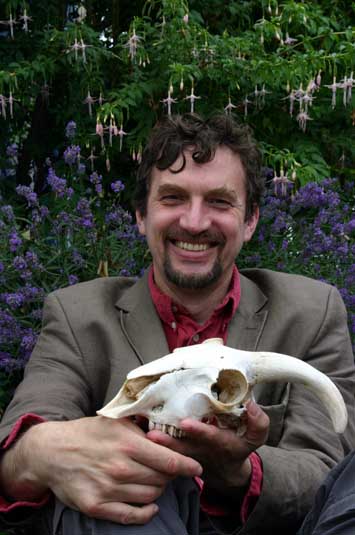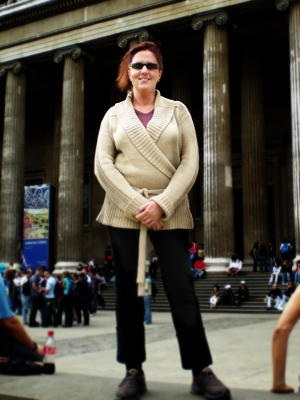Live Interpretation Manager of Historic Royal Palaces and King Arthur Expert Christopher Gidlow is the Live Interpretation Manager of Historic Royal Palaces. He specialises in bringing history to life at the Tower of London, Hampton Court Palace, Kensington Palace and the Banqueting House Whitehall. He is also responsible for interpretation on the project to open the Georgian Kitchens of Kew Palace to the public. He is also a director of the International Museum Theatre Alliance (Europe). A life-long enthusiast for the Arthurian legends, Christopher describes being told by his primary teacher that they might have a basis in fact as…
-
-
The New Acropolis Museum is arguably the most high-profile building to go up this decade (since we in New York are still peering into a big hole in the ground that is supposed to produce a new World Trade Centre). Essentially a smack in the face of the British Museum’s argument that Athens has no suitable venue in which to house the Elgin Marbles, it’s also the most controversial. I spoke to Bernard Tschumi, the outspoken architect who designed this extraordinary building. Replacing the smaller old Acropolis Museum, the purpose-built new museum ensures that architectural treasures too delicate to be…
-
Geoff Holder Author and forteana expert Geoff Holder is the author of more than a dozen books on everything mysterious, paranormal, strange, gothic and grotesque. His books are an authoritative mix of extensive historical study combined with diligent field research. They are often geographically-based, with titles such as The Guide to Mysterious Glasgow and The Guide to the Mysterious Lake District. Holder is primarily interested in ‘forteana’ – the world of the odd, the curious, the wondrous, the allegedly paranormal – and its fractious and informing relationship with the so-called mundane world. What do people do when they have too…
-
Architecture in Roman Britain by Guy de la Bédoyère The Roman period was Britain’s first great architectural age, though this is difficult to appreciate from the ruinous state of the sites that survive. Understanding the types and range of buildings that existed in Roman Britain depends on careful excavation of foundations and wall footings, together with fragments of windows, roofs and carved architectural decoration discovered among the debris. When this evidence is taken together with examples of better-preserved buildings that still exist in Europe, the Near East and North Africa, it is possible to recreate something of the architecture of…
-
Yuval Peleg Israeli Antiquities Authority’s head district archaeologist for the Jordan Valley Israeli Antiquities Authority archaeologist Yuval Peleg is the head district archaeologist for the Jordan Valley. His excavations at Qumran, conducted mainly from 1993-2004, have brought him into the middle of the debate raging over the Dead Sea Scrolls. He worked alongside fellow archaeologist Yitzhak Magen. The two of them found that the site was not an Essene settlement and that the scrolls were deposited in nearby caves by refugees fleeing the Roman army, after the fall of Jerusalem, in 70 A.D. Peleg holds an MA in archaeology from the…
-
Description Zahi Hawass takes you inside the new tombs at Saqqara, the Valley of the Kings, and the temple of Taposiris Magna. See the tombs of Nefret-swt and Qar, and come along on the search for KV64 and the tomb of Cleopatra and Mark Antony! Related Heritage Experts Zahi Hawass Credits Images by Sandro Vannini & Niccolò Piazza Transcription If someone ask me a question now and say: «What is the most recent discovery that you made?» I can say: «I’m inside a tomb located west of the step pyramid, the oldest pyramid in Egypt». This tomb is under the…
-
Paula Veiga Researcher in Egyptology 13 April 1968 Paula Veiga has a background in tourism, but holds a Master in Pre Classical Studies from the University of Lisboa and a Master in Biomedical Egyptology from the Faculty of Life Sciences, University of Manchester (which covers Histology studies and laboratory practice, DNA studies and practice of extraction, Paleopathology, Osteology, amongst other disciplines). She recently published her first book – Oncology and Infectious Diseases in ancient Egypt: The Ebers Papyrus? Treatise on Tumours 857-877 and the cases found in ancient Egyptian human material and has another one upcoming. Paula Veiga is working on…
-
What lies behind the legends of King Arthur? Fragments of history, or just wishful thinking? While historians study the ancient manuscripts, modern archaeologists join in the hunt for clues. From Arthur’s ‘birthplace’ at Tintagel to the fabled ‘Isle of Avalon’, we sift through the evidence. Journeying across Arthur’s Britain, we search for Camelot and the sites of his battles. Do the remains confirm or contradict the traditional accounts? Far from providing objective proof, Christopher Gidlow shows how archaeologists’ interpretation of their discoveries reflects the academic fashions of their times. Sites which in the 1960s were used to prove King Arthur’s…
-
Attribution: Taken from the ‘One & Other’ live video stream. mike pitts Archaeologist and editor of British Archaeology magazine Mike Pitts is an influential freelance archaeologist and writer who edits British Archaeology magazine (since 2003). He has also written trade books such as Fairweather Eden and Hengeworld, and has produced features for BBC History, New Scientist and American Archaeology. A novel and a non-fiction book are also in the pipeline, and Mike has also waded into the world of radio broadcasting with a historical drama for BBC Radio 4. Mike claims his love for archaeology grew from his first observation of…
-
Archaeologists have made two major tomb discoveries at the ancient city of Petra in southern Jordan. They discovered a rock-cut tomb that contained the skeletal remains of 61 individuals, along with a wealth of wooden artefacts, animal bones and ceramics. The second discovery was made at a place called tomb 676. While excavating it archaeologists found a gold medallion with an Islamic inscription on it. The find dates to long after the tomb was abandoned. “This object was placed in the tomb in a later period – perhaps as a way of warding off evil coming from the tomb,” said Professor David Johnson, of Brigham Young University in Utah, who led the team that made both tomb…





